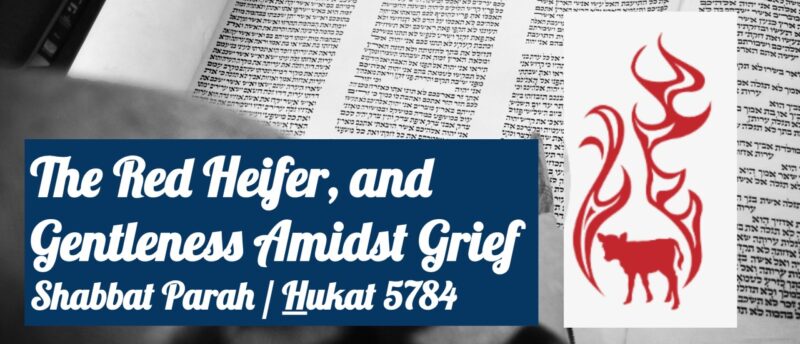This week’s Torah portion, Hukat, begins with the parah adumah. The Israelites are instructed to bring a red heifer who has never borne a yoke. The priest takes it outside the camp and offers it, burning it along with hyssop, cedar wood, and something crimson. Its ashes are kept for making mei niddah hatat, “waters of lustration,” used to “purify” someone after contact with death. (More on that in a moment.)
This is weird, and not just to us. Rashi observed that the nations of the world would taunt us about the oddity of this law, which is why it’s called a hok. Hukim are the category of mitzvot that may not make logical sense, like kashrut. We observe them as a spiritual discipline, part of accepting “the yoke of heaven,” tradition’s way of saying there’s something in the universe more mysterious than we can grasp.
I see hukim the way I see poetry that’s allusive and evocative. If I approach this like a poem or a piece of visual art, I notice how this parsha is shot through with the recurring theme of death. Immediately after the parah adumah, we read that someone who touches a dead body becomes tamei for seven days. Tum’ah is Torah’s term for the spiritual condition of having coming into contact with life or death.
In Torah’s understanding we become tamei upon encountering a dead body, menstrual blood or semen, certain forms of illness. I follow R. Rachel Adler in understanding tum’ah as a kind of spiritual-electrical charge. Someone who’s tamei is temporarily vibrating at a different frequency than everyone else. This is the spiritual state that the waters of lustration were used, in Torah times, to wash away.
The first time I served on our hevra kadisha I understood this in a new way. It’s not that touching the bodies of our dead is somehow “unclean.” It’s more like: once I had helped to wash and dress and bless the body that had once held the soul of a human being, I felt changed. The world outside the funeral home felt weird. I felt spiritually out of phase, not quite in normal time, for a little while.
I remember feeling that way after late-night shifts when I was a student chaplain at Albany Medical Center, too. After holding the hand of someone who was dying, or praying with someone headed into emergency surgery, nothing felt the same. As I learned much later, it’s also how I felt after giving birth: I felt fragile, precarious, both heightened and dissociated, temporary and eternal all at once.
Today the parah adumah ritual is impossible. There is no high priest to make a sacrifice in the appointed place in the appropriate ways. Rambam even suggested that only one more parah adumah will ever be born, to be brought by the messiah. There are no waters of lustration anymore. Especially now that the ritual literally can’t be performed, we grow and learn through studying it rather than actually doing it.
In place of the waters of lustration, we’ve evolved other rituals to close shiva. For instance, walking around the block and going back in through a different door: embodying both our readiness to re-enter the world, and also how mourning has made us different than whoever we were before. But the central idea that death impacts us and we need a transition to return to normalcy still rings true.
Reading about death and tum’ah this year I can’t help thinking about Israel and Palestine. I think about the violent deaths of Israelis at the Nova music festival and the kibbutzim that were attacked on October 7. I think about the violent deaths of Palestinians in Gaza over the last 281 days. Everyone there has touched death, and no one has had the luxury of time to mourn, nor closure for their grief.
I yearn for waters of lustration that could wash away their vast grief (and ours) and soften the hearts of those who have power to create change. I wish we had a way to balm every wounded soul and body in Israel and Palestine. Healing feels impossible – as impossible as a ritual that demands a place and a role that haven’t existed in 2000 years and a sacrificial modality of prayer we no longer use.
In times like these I’m grateful that our tradition is built on hope that no matter how broken our world has been, and this year we’re all aware that it is plenty broken, a better future is possible. Even if I don’t know how we’re going to get there. The truth is, it’s not my job to know how the world is going to get there. It’s my job to care for y’all. And it’s aleinu, on all of us, to do what we can to build better.
One of my most profound memories of hospital chaplaincy is the night a kid was hit by a train. I wasn’t yet a parent, and I remember saying to my chaplaincy supervisor that I don’t know how I could have borne the parents’ grief if I were. He told me that no matter what, faced with this kind of grief, all we can really give is our heart, our presence, our care. It’s the holiest gift human beings have to give.
I can’t make sense out of the magnitude of loss in Gaza and Israel. Any single person’s grief can be infinite. The grief of whole peoples…? There are no words. And that brings me back to the idea of a hok, a mitzvah we can’t explain. Accepting the “yoke of heaven” means accepting that we can’t always make sense of the world. In the face of this much grief, we may not be able to make anything “okay.”
But we can feel-with one another, and we can insist on empathy for every Israeli and every Palestinian. I know that some people think my empathy is misplaced, or that it benefits the wrong people. For me, empathy is a core spiritual discipline, and part of that discipline is extending it to everyone. Faced with inconceivable loss, our hearts and our care are all we have; they are the holiest gift we have to give.
May this Shabbat Parah bring peace to all who mourn, and comfort to all who are bereaved.
This is the d’var Torah that Rabbi Rachel offered at Kabbalat Shabbat services (cross-posted to Velveteen Rabbi.)






